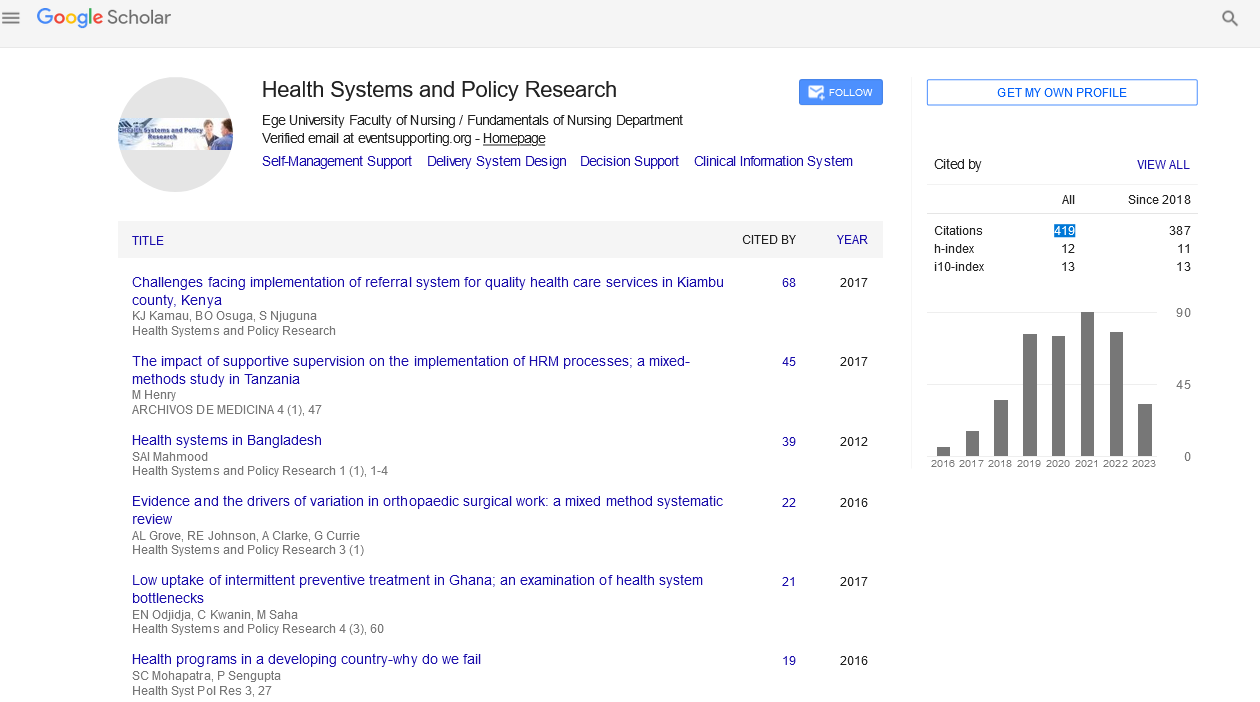Perspective - (2024) Volume 11, Issue 4
Healthcare Financing: Challenges and Solutions
Susan Wilhelmsson*
Department of Healthcare, University of Technisc, Darmstadt, Germany
*Correspondence:
Susan Wilhelmsson, Department of Healthcare, University of Technisc, Darmstadt,
Germany,
Email:
Received: 02-Jul-2024, Manuscript No. IPHSPR-24-14985;
Editor assigned: 05-Jul-2024, Pre QC No. IPHSPR-24-14985;
Reviewed: 19-Jul-2024, QC No. IPHSPR-24-14985;
Revised: 01-Aug-2024, Manuscript No. IPHSPR-24-14985;
Published:
29-Aug-2024
Introduction
Healthcare financing is a critical component of any modern
society, influencing access to medical services, quality of care
and overall health outcomes. As nations grapple with aging
populations, evolving medical technologies and increasing costs,
the landscape of healthcare financing becomes increasingly
complex. This article explores the challenges and solutions in
healthcare financing, offering insights into current issues and
potential pathways forward. Healthcare financing refers to the
mechanisms that individuals, governments and organizations
use to pay for healthcare services. These mechanisms can be
broadly categorized into public and private funding sources.
Public financing includes funds allocated by governments
through taxation or social health insurance schemes, aiming to
provide universal coverage. Private financing involves out-ofpocket
payments by individuals, private health insurance and
employer-sponsored health plans.
In many countries, a mix of public and private financing
models coexists, each with its strengths and limitations. For
instance, countries like the United States predominantly rely on
private health insurance, whereas nations such as the United
Kingdom emphasize public funding through taxation for their
National Health Service (NHS).
Description
The current landscape of healthcare financing
Healthcare financing refers to how financial resources are
collected, allocated and used to provide medical services. It
encompasses public and private funding mechanisms, insurance
systems, out-of-pocket payments and government subsidies. The
goals are to ensure equitable access to healthcare, improve
health outcomes and manage costs effectively.
Key challenges in healthcare financing
Rising costs: Healthcare expenditures continue to escalate
due to factors such as technological advancements, an aging
population needing more care and increased demand for
services.
Inequitable access: Disparities in access to healthcare services
persist, driven by socioeconomic factors, geographical location
and insurance coverage gaps.
Financial sustainability: Ensuring healthcare systems remain
financially sustainable is a significant challenge, especially with
unpredictable costs and budget constraints.
Types of healthcare financing systems
Single-payer systems: In a single-payer system, such as in
Canada or the UK, healthcare is funded by a single public
authority (usually the government) that collects taxes and pays
for healthcare services for all residents. This system aims to
provide universal coverage and reduce administrative costs.
Multi-payer systems: Countries like Germany and Switzerland
operate multi-payer systems where healthcare is funded
through a combination of public and private sources. Citizens
may choose from competing health insurance providers,
promoting efficiency and choice but potentially leading to
inequities in coverage.
Mixed systems: Many countries, including the United States,
have mixed systems combining elements of both single-payer
and multi-payer systems. Private insurance coexists with public
programs like medicare and medicaid, creating a complex
landscape of coverage and costs.
Innovations in healthcare financing
Value-based healthcare: Value-based healthcare models
prioritize outcomes over services provided, incentivizing
providers to deliver high-quality care efficiently. Payment
models may include bundled payments for episodes of care or
pay-for-performance incentives.
Digital health and telemedicine: Technological advancements
have transformed healthcare delivery, offering remote
consultations, digital health records and telemedicine services.
These innovations can improve access to care, reduce costs and
enhance patient outcomes.
Social impact bonds: Social Impact Bonds (SIBs) involve
private investors funding social programs, including healthcare
initiatives. Returns on investment are tied to achieving
predefined outcomes, incentivizing efficiency and innovation in
service delivery.
Policy interventions and future directions
Healthcare reform: Governments globally are exploring
healthcare reform to address financing challenges. This includes expanding coverage, controlling costs through regulation and
improving the efficiency of healthcare delivery systems.
Health technology assessment: Assessing the costeffectiveness
of medical technologies and treatments is crucial
for informing healthcare financing decisions. Health Technology
Assessment (HTA) frameworks help prioritize resource allocation
based on clinical and economic evidence.
Investment in prevention and primary care: Promoting
preventive healthcare and strengthening primary care services
can reduce the burden of chronic diseases and prevent costly
hospitalizations. Investing in these areas can lead to long-term
cost savings and improved population health.
The importance of healthcare financing
Effective healthcare financing is crucial for several reasons:
Universal access: It ensures that all individuals, regardless of
socioeconomic status, can access essential healthcare services.
Quality of care: Proper financing supports investments in
medical technology, infrastructure and healthcare professionals,
thereby improving the quality of care delivered.
Financial protection: Adequate financing reduces the
financial burden on individuals during times of illness or injury,
protecting households from catastrophic healthcare costs.
Health outcomes: Countries with robust healthcare financing
systems generally exhibit better health outcomes and higher life
expectancies among their populations.
Conclusion
Healthcare financing is a multifaceted challenge requiring
innovative solutions and collaboration across sectors. As
countries strive to achieve universal health coverage while
managing costs and improving quality, strategic investments in
technology, policy reform and healthcare delivery models will be
pivotal. By addressing these challenges with foresight and
adaptability, societies can build sustainable healthcare systems
that meet the needs of all individuals, ensuring equitable access
to quality care for generations to come.
Citation: Wilhelmsson S (2024) Healthcare Financing: Challenges and Solutions. Health Syst Policy Res, Vol.11 No.4: 038





